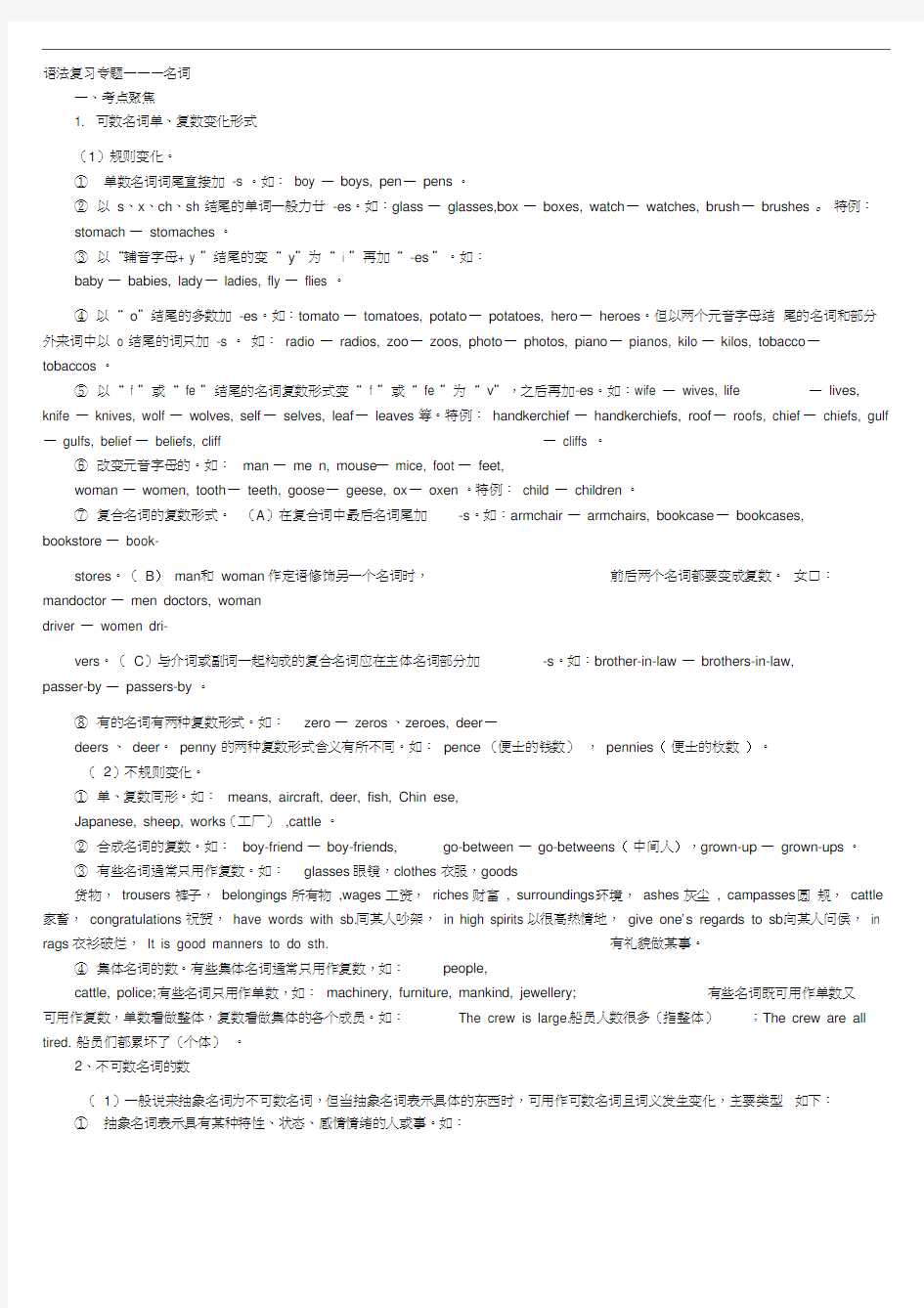高考英语复习专题共个专题


语法复习专题一——名词
一、考点聚焦
1. 可数名词单、复数变化形式
(1)规则变化。
①单数名词词尾直接加-s 。如:boy —boys, pen —pens 。
②以s、x、ch、sh 结尾的单词一般力廿-es。如:glass —glasses,box —boxes, watch —watches, brush —brushes 。特例:
stomach —stomaches 。
③以“辅音字母+ y ”结尾的变“ y”为“ i ”再加“ -es ”。如:
baby —babies, lady —ladies, fly —flies 。
④以“ o”结尾的多数加-es。如:tomato —tomatoes, potato —potatoes, hero —heroes。但以两个元音字母结尾的名词和部分外来词中以o 结尾的词只加-s 。如:radio —radios, zoo —zoos, photo —photos, piano —pianos, kilo —kilos, tobacco —
tobaccos 。
⑤以“ f ”或“ fe ”结尾的名词复数形式变“ f ”或“ fe ”为“ v”,之后再加-es。如:wife —wives, life —lives, knife —knives, wolf —wolves, self —selves, leaf —leaves 等。特例:handkerchief —handkerchiefs, roof —roofs, chief —chiefs, gulf —gulfs, belief —beliefs, cliff —cliffs 。
⑥改变元音字母的。如:man —me n, mouse —mice, foot —feet,
woman —women, tooth —teeth, goose —geese, ox —oxen 。特例:child —children 。
⑦复合名词的复数形式。(A)在复合词中最后名词尾加-s。如:armchair —armchairs, bookcase —bookcases,
bookstore —book-
stores。(B) man和woman作定语修饰另一个名词时,前后两个名词都要变成复数。女口:mandoctor —men doctors, woman
driver —women dri-
vers。(C)与介词或副词一起构成的复合名词应在主体名词部分加-s。如:brother-in-law —brothers-in-law,
passer-by —passers-by 。
⑧有的名词有两种复数形式。如:zero —zeros 、zeroes, deer —
deers 、deer。penny 的两种复数形式含义有所不同。如:pence (便士的钱数),pennies(便士的枚数)。
(2)不规则变化。
①单、复数同形。如:means, aircraft, deer, fish, Chin ese,
Japanese, sheep, works (工厂),cattle 。
②合成名词的复数。如:boy-friend —boy-friends, go-between —go-betweens(中间人),grown-up —grown-ups 。
③有些名词通常只用作复数。如:glasses眼镜,clothes 衣服,goods
货物,trousers 裤子,belongings 所有物,wages 工资,riches 财富, surroundings 环境,ashes 灰尘, campasses 圆规,cattle 家畜,congratulations 祝贺,have words with sb. 同某人吵架,in high spirits 以很高热情地,give one's regards to sb. 向某人问侯,in rags 衣衫破烂,It is good manners to do sth. 有礼貌做某事。
④集体名词的数。有些集体名词通常只用作复数,如:people,
cattle, police; 有些名词只用作单数,如:machinery, furniture, mankind, jewellery; 有些名词既可用作单数又
可用作复数,单数看做整体,复数看做集体的各个成员。如:The crew is large. 船员人数很多(指整体);The crew are all tired. 船员们都累坏了(个体)。
2、不可数名词的数
(1)一般说来抽象名词为不可数名词,但当抽象名词表示具体的东西时,可用作可数名词且词义发生变化,主要类型如下:
①抽象名词表示具有某种特性、状态、感情情绪的人或事。如:
抽象名词(不可数) 具体化(个体名词,可数名词)
in surprise 惊讶地 a surprise 一件令人惊讶的事 win success 获得成功 win honor 赢得荣誉
an honor
Failure ( 失败 )is the mother of success a success 一个(件)成功的人 (事) 一个(件)引以为荣的 (事) a failure
失败者
失败是成功之母。
by experience 靠经验 an experience 一次经历
youth 青春
a youth
一个青年人
have pity on sb. 怜悯某人 a pity 可惜的事情
with pleasure 乐意 a pleasure 乐事
②抽象名词与a(an)连用,淡化了抽象概念,转化为似乎可以体验到的动作、行为或类别。如:
A kno wledge of En glish is a must in intern ati onal trade.
Would you like to have a walk (swim, bath, talk) with me?
It is waste of time reading such a novel.
She made an apology to her mother for her wrong doin gs.
(2) 物质名词是不可数名词,但表示数量或种类之多时,可以用作可数名词。如:
①物质名词有形或数的相应物体,有单、复数。如:some coffee 一些咖啡,a coffee 一杯咖啡,three coffees 三杯
咖啡,some drink —些饮料,a drink —杯饮料,three drinks 三杯饮料,his hair 他的头发,a few grey hairs 几根白发,glass玻璃,a glass 一只玻璃杯。
②物质名词有前置后置修饰时,前面要使用不定冠词。
.have breakfast I The road is covered with snow.
? have a wonderful breakfast They have a heavy snow every year.
>Time and tide wait for no man.
■■: We had a wonderful time last night.
'- (3)有复数形式的不可数名词
①有些抽象名词往往以复数形式岀现,起到一种丰富语言感情色彩或强调某种特殊状态的作用。如:
Use your brains, please.
They have smoothed away the difficulties.
Have you made preparations for tomorrow ' s meeting?
Many tha nks for your kindn ess.
No pains, no gains.
After many failures, they fin ally succeeded.
②有些物质名词以复数形式岀现,表示数量之多,范围之广。如:
The boy burst into tears at the bad n ews.
The rising waters did a lot of harm to the crops.
The stone bridge broke dow n in heavy rains.
3. 名词所有格
(1)s”所有格的特殊表示形式有:
①用于表示时间、距离、价格、重量等的名词后,如:today ' s
newspaper, five minutes ' walk(drive),five pounds ' weight, ten dollars ' worth of coffee 。
②用于表示国家、世界、城市等地方的名词后。女口:the earth ' s planet, the word' s population, China' s industry,
New York' s parks。
(2)“of”所有格的特殊表示方式有:
①表示"部分”时,一般在所修饰的名词前有一个表示数量的词(a、two、several、some no、many等),女口:Somestudents
of Mister Zhang ' s have gone to college. 张老师的一些学生已经上大学了。
②表示"其中之一,其中一部分”的意思时,用: a friend of Tom ' s
汤姆的一个朋友(许多朋友中的一位)。
③表示赞扬、批评或厌恶等感情色彩时,应该用:that/this/these/
those + 名词(单、复数)of Mary ' s/yours/his/hers 。如:
That inven tion of hers belo ngs to the world. 她的那项发明是属于全世界的(表赞赏)
4、名词作定语
英语中有些名词没有其对应的同根形容词,这些名词可以直接用来作定语修饰另一个名词。
(1)分类意义。
air polluti on 空气污染boy frie nd coffee cup 咖啡杯in come tax tennis ball 网球song writer
body lan guage 身体语言road accide nt Nobel Prize 诺贝尔奖
(2)时间、地点、称呼等。
男朋友
所得税
歌曲作家
交通事故
Doctor Jack 杰克医生 Professor Li 李教授 eve ning
school
1 夜校
win ter sleep 冬眠
street dance 街舞 cou ntry music 乡村音乐
village people
村民
school educati on
学校教育
Chi na problem
中国问题
(3)表目的、 手段、来源, 所属意义。
recepti on
desk
接待台 sports field 田径场 stone table 石桌 color TV 彩电
weather report 天气预报 二、精典名题导解 选择填空
1. It is gen erally believed that teachi ng is ________ it is a scie nee. (NMET 2001)
A. an art much as
B. much an art as
jour ney arou nd the world took the old sailor nine moths, the saili ng time was 226 days.
A. of which
B. duri ng which
C. from which
D. for which
解析:答案为 B 。辨析名词语义,a dista nee of + 数字“ ......... 距离"。 6. I keep medicines on the top shelf, out of the children ' s _________ .
A. reach
B. hand
C. hold
D. place
解析:答案为 A° “out of reach ”是“超岀某人够得着的范围”
,即“够不着”的意思,药品应放到孩子够不到的地方。 语法复习专题二
冠词
一、考点聚焦 1.
不用冠词的情况
(1) 专有名词、物质名词、抽象名词、人名、地名等名词前,一般不加冠词。 China, America, Smith Air is matter.
(2) 可数名词前有物主代词、指示代词、名词所有格等限制时,不加冠词。 This dictionary is mine.
(3) 季节、月份、星期、节日、假日、一日三餐名称前一般不加冠词。 March, May Day, National Day, Children ' s Day, Women' s Day Have you had supper?
Spri ng is the best seas on of the year. (4) 称呼语或指家用雇用的 nurse 、cook 等名词前及表示头衔职务的名词作宾语、补语及同位语时,一般
不加冠词。
C. as an art much as
D. as much an art as
解析:答案为Do 当名词前有 what 、so 、as 、too 、quite 等词修饰时,其形容词被这些词修饰, 组成下列结构,
a n ice book! This is too heavy a box for me to carry. He is not as hon est a boy as Mike.
等,应采取
容词(副词)+ a(a n) + 2. The police are offeri ng a _________ A. price B. prize C. reward
解析:答案为 C o price 价格,价钱; 确理解名词的含义及其搭配是活用语言的基础, 辨析名词,从而选择最符合句意的
选项。
'II find this map of great ____________ A. price 解析:答案为 成本)不符合题意,
“有用,有价值” you buy more tha n ten, they knock 20 pence off . ______
A. a price
B. price
C. the price
D. price
解析:答案为 G 本题考冠词和名词。全句合理句意应是:如果你买超过
名词的形式。要记住一些类似的特殊结构,并加以分析。
to anyone who can give in formatio n about the lost key.
D. money
prize 奖金。D 项是钱,属不可数名词,题中所要填的是“酬金,报酬”
在复习备考中要熟练掌握考纲中一些名词的词义、
搭配、习惯等,才能更好 如:What
too/how + 形
(NMET 1999)
。^注丿意^正
in help ing you to get rou nd
London. B. cost C. value D. useful ness C 。本题考查特定语境中名词的词义及“
be of +
value 作“ quality of being useful or desirable
故选择value o 注意名词词义辨异及惯用法表达,题中“
抽象名词”结构。 解时,常与 of + NMET 1998) Price ( 价格),cost
of 搭配,在句中作表语或补语,意为
抽象名词”相当于该名词的形容词形式。
(价钱,费用,
10个,他们从(现在标岀的)价格上减价
20
What' s this, Father? We made him our chairma n.
Ask n urse to put the child to bed. Professor Li.
(5)学科名称、球类、棋类名称前不加冠词。
Do you study physics?
He likes playi ng football/chess.
(6)复数名词表示泛指一类人或事物时前不用冠词。
They are peasa nts/ workers.
(7)在与by连用的交通工具名称前不加冠词。
by car, by bus,by bike, by tra in, by air/ water/ la nd
但:take a bus, come in a boat, on the train/ bus 需注意。
(8)某些固定词组中不用冠词。
①名词词组中:
husba nd and wife, brother and sister, body and soul, day and ni ght, knife and fork
②介词词组中:
to(at, from) school, in (to)class, in (to,at, from)u ni versity ( college ),to ( in, in to, from ) church, to(i n,i nto,
out of)prison(hospital, bed), to(at, from, out of)work, to(in, from) town,at (from)home, to(at)sea, at night(noon,
midni ght), by car (bus, bicycle, pla ne), on foot
注意:在有些词组中,有无冠词含义不同。
in hospital 住院(因病)
in the hospital 在医院(工作、参观等)
pin fron t of 在前面,指某物体之外
坤in the front of 在前部,指某物之内
f in charge 负责,主管* out of question 没问题
* in the charge 由 ....... 负责out of the questi on 不可能
、(9) as引导的让步状语从句中,作表语的名词不带冠词。
Child as she is, she knows a lot of Fre nch.
(10)系动词turn (作“变成”解)后作表语的单数可数名词前习惯不用冠词。
The you ng girl has turned writer.
=The you ng girl has become a writer.
(11)在单数名词+ after + 同一单数名词(表示“一个接一个”)结构中,单数可数名词前不加冠词。
She did experime nt after experime nt.
类似的还有:shop after shop, mistake after mistake
(12)形容词的最高级前、序数词前也有不用定冠词的情况。
①“ most +形容词原级"作“十分、非常、极"解时,前面不用定冠词。
Oh, it ' s most beautiful.
②当两个形容词最高级并列修饰同一个名词时,第二个形容词前通常不用定冠词。
She is the tallest and fattest girl in our school.
③当形容词最高级作表语,不表示与其他人或物相比时,其前不用定冠词。
The market in the cou ntry is busiest in win ter.
④形容词最高级前有名词所有格或物主代词时,不能用定冠词。
A wolf in a sheep ' s skin is our most dangerous enemy.
⑤序数词前面一般加定冠词表示“第. "之意,但在second、third 等词前加不定冠词表示“又一,再一"之意
…why you took a sec ond arrow
注意:下句中“ a first ”表示“第一名、冠军”。
He is a top stude nt in our class; he ofte n gets a first in maths.
(13)no与such连用时应放在such之前,such后面的名词不用冠词。
No such thi ng has ever happe ned in this village.
(14)never、ever置于作主语的名词前,这些名词前不用冠词。
Never did stude nt study so hard. 这个学生从未学得这么认真。
(15)有时为了节省空间、时间、金钱和精力,或为了引起注意力,省去a(n)或the,这主要用于新闻标题、工商业文
件、广告、电报、公告、提纲、书名等。
Con fere nee ope ns. 会议召开了。
2. 定冠词的使用情况
(1)使用定冠词的一般情况。
①特指或第二次提到。
②序数词前、最高级前、独一无二的东西前。
③用于表示发明物的单数名词前或某些专有名词前。
(2)定冠词使用特殊的场合。
①He hit him in the face.
beat sb. on the no se, take sb. by the arm, pat sb. on the head ② the rich, the poor, the wou nded 富人,穷人,伤员
③the elder of the two, he more beautiful of the two 两者中较年长的一位,较漂亮的一个
④The soon er, the better. 越快越好。
⑤He got paid by the hour. 他是按小时付工钱的。
by the yard/the doze n/the mon th/the year ?…
但:by weight 按重量
⑥in the 50s /in the 1870s (表示年代)
⑦the Smiths/the Whites (表示一家人或夫妇俩)
⑧in the water/field/light/shade/distance/middle/country/rain
⑨tell the truth/on the other hand/on the way home
⑩当抽象名词表示某一特定内容,特别是当它有一限定性修饰语时,它与定冠词连用:
「She is fond of music.
“ He is playi ng the music writte n by Beethove n.
\ Good advice is beyond price.
* I' m sorry not to have taken the advice he gave.
3. 不定冠词常用的几种情况
(1)表示"一”相当于" one”。I ' ll return in a day or two.
(2)表示"每”相当于" per ”。We have three meals a day.
(3)表示 "同一性”相当于" the same ”。The children are of an age.
(4)表示类指,表示 "某类”。He wants to he a doctor.
(5)表示泛指,相当于" any ”。A horse is a useful animal.
(6)表示某一个,相当于" a certain ”。A Mr. Smith is asking to see you.
(7)与抽象名词连用,可以表示"一场、一次、一件" ,如:a pleasure 一件乐事,a surprise 一件令人惊讶的事, a
joy 一件高兴的事,a pity 一件遗憾的事,an honour —个(件)经以为荣的人(事)。
(8)与物质名词连用,表示“一种,一阵、一份”。
What a heavy rain!
What a good supper!
Please give me a black coffee!
4. 冠词表类别的常见方式
(1) 定冠词+单数可数名词,表示一个,代表一类。
The computer was inven ted in 1945.
The TV set was inven ted by Joa n Baird.
The horse is a useful ani mal.
(2) 不定冠词+单数可数名词(表示任意一个,某一个) 。
A pen is a tool for writi ng.
A square has four sides.
